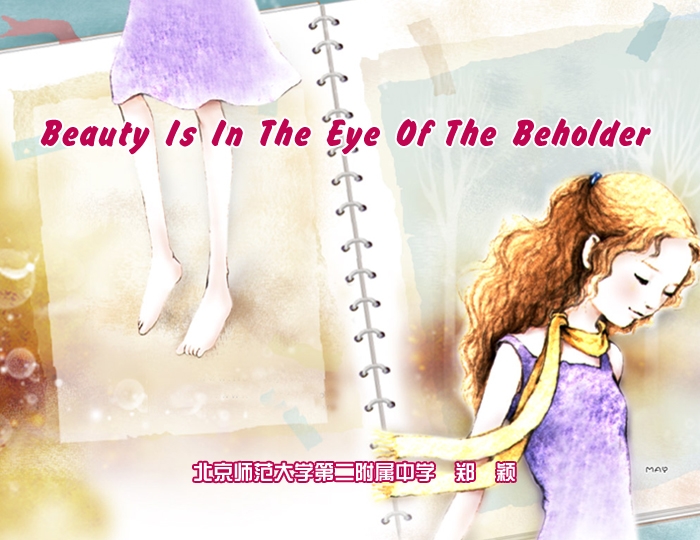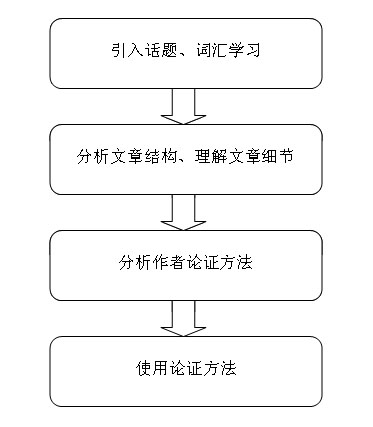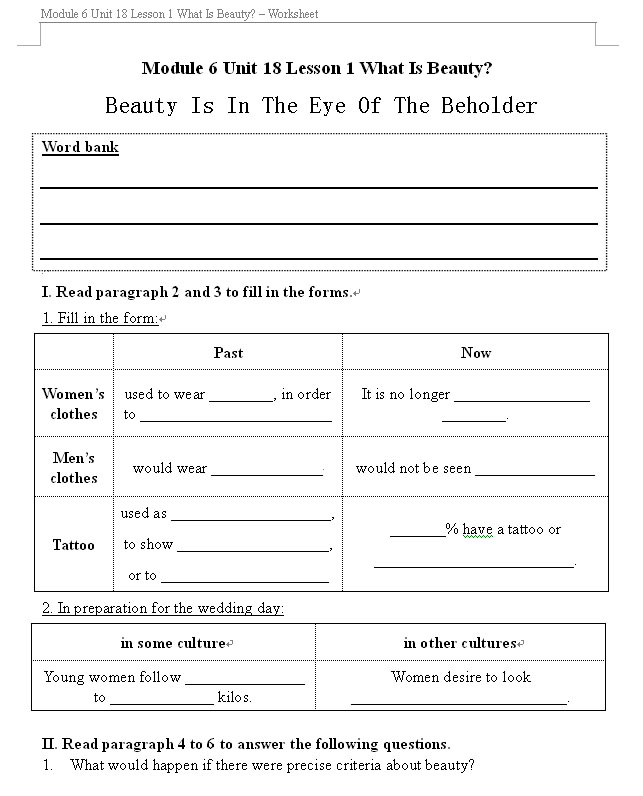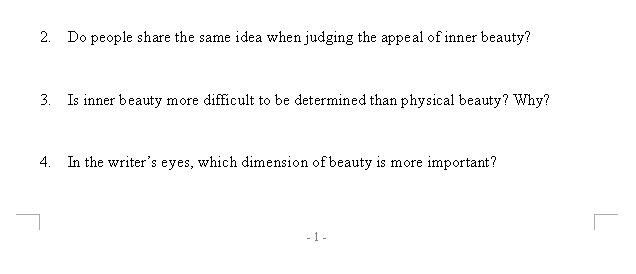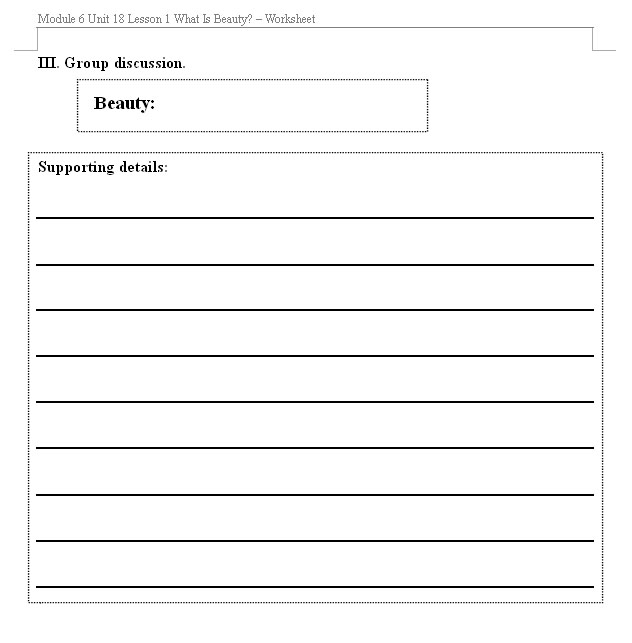|
教学过程(表格描述)
|
|
Stage 1: Pre-reading
|
|
Steps
|
Students’ activities
|
Teacher’s activities
|
Purposes
|
Time
|
|
Step 1
|
Examine 8 portraits and tell which one is their favorite and the reasons.
|
Shows Ss 8 portraits and asks Ss to tell which one is the most attractive in their eyes and the reasons.
|
To introduce the topic to Ss and raise their awareness of the variety of their opinions.
|
4’
|
|
Step 2
|
Learn some new words and take down necessary notes.
|
Summarizes Ss’ opinions briefly and introduces some new words.
|
To prepare Ss for reading.
|
|
【Stage 1 设计说明】
这部分读前活动的设计源自对文章特点和学生特点的分析,为之后的阅读和讨论做了两方面的准备:
1)话题引入:展示8张人像图片,让学生说出自己眼中最美的一个,并解释原因。以此让学生意识到彼此之间审美标准和角度的不同。
2)词汇学习:在总结学生发言的过程中,自然地引入一些文章中即将出现的生词,并提示学生在学案的word bank部分进行必要的记录。这样的词汇学习既轻松自然又缓解了之后阅读环节的词汇障碍。
|
|
Stage 2: While-reading
|
|
Steps
|
Students’ activities
|
Teacher’s activities
|
Purposes
|
Time
|
|
Step 1
|
Read the 1st paragraph to answer the T’s questions.
|
Asks Ss to read the 1st paragraph to find out the meaning of the title and the factors that change the standards of beauty.
|
To check Ss’ understanding of the title and prepare for further reading.
|
4’
|
|
Step 2
|
Read the next two paragraphs and match the paragraphs with the two factors.
|
Asks Ss to identify the paragraphs talking about the 2 factors and the topic sentence of them.
|
To practise Ss’ skill of skimming and prepare for further reading.
|
|
Step 3
|
Read paragraph 2 and 3 to fill in the forms in worksheet Part I and share the answers afterwards.
|
Asks Ss to read paragraph 2 and 3 to fill in the forms in worksheet part I and check answers afterwards.
Observes the class to offer necessary help while Ss are reading.
|
To practise Ss’ skill of reading for details and understand the details.
|
6’
|
|
Step 4
|
Review what they have read.
|
Helps the Ss draw a tree structure of the first three paragraphs.
|
To clarify the structure of the first 3 paragraphs and prepare for further discussion.
|
2’
|
|
【Step 1-4设计说明】
读中活动的这4个步骤引导学生对文章的1-3段进行了分析。通过阅读和分析,让学生理解文章标题的含义,发现作者提出的影响美的评价标准的两个因素:时间和文化,读懂作者对这两个因素的解释。设计这4个步骤时,我特别关注了如下几点:
1)明确段落的主题、细节和结构,为读后活动做准备。
作者在第2、3段分别论述了时间和文化这两个影响因素,并用举例、对比等方式对两者进行了深入的解释。我在设计问题时,让学生先找出各段的主题,再深入寻找细节。并在第4步中和学生一起画出了前三段的树形结构图,图中包括各段的主题和细节。这样就让学生对主题、细节和结构有了初步的了解,为之后分析作者如何用细节论证主题做好了铺垫。
2)在阅读中处理词汇。
由于本篇文章的生词较多,所以我在设计处理细节信息的任务时,适时地采用了标注、释义、复现、初步运用等方法,对词汇进行了初步的处理。例如对纹身意义的猜测,对不同文化背景下的新娘的描述等。这些设计,旨在帮助学生更准确地理解文章的细节,初步落实词汇知识。
3)遵循阅读习惯,培养正确的阅读习惯和多种阅读能力。
在设计阅读任务时,我特别关注阅读任务和真实阅读习惯的相符性,让设计的阅读任务尽量贴近生活中的真实的阅读过程。例如阅读第一段理解文章标题、先把握第2、3段的段落主题再寻找相关细节。这些活动的安排符合真实阅读情境中的阅读理解的习惯。同时,也锻炼了学生速读把握中心、查读寻找细节等各种阅读能力。
|
|
Steps
|
Students’ activities
|
Teacher’s activities
|
Purposes
|
Time
|
|
Step 5
|
Predict what will be mentioned in the rest part of the article.
|
Asks Ss to predict what will be mentioned in the rest part of the article.
|
To practise Ss’ skill of predicting and prepare for further reading.
|
1’
|
|
Step6
|
Read the rest part to look for topic sentence of each paragraph.
|
Asks Ss to skim the rest part and locate the topic sentence of each paragraph.
|
To practise Ss’ skill of skimming and prepare for further reading.
|
3’
|
|
Step7
|
Read paragraph 4 to 6 to answer the questions in worksheet part II and share answers afterwards.
|
Asks Ss to read paragraph 4 to 6 to answer the questions in worksheets part II and check answers afterwards.
Observes the class to offer necessary help while Ss are reading.
|
To practise Ss’ skill of reading for details and understand the details.
To prepare Ss for further discussion.
|
6’
|
|
【Step 5-7 设计说明】
读中活动的这3个步骤引导学生对文章的4-6段进行了分析。这3段是文章中句子较长,句子结构比较复杂的3段。通过设计阅读任务,让学生读懂审美标准变化的原因,了解内在美的重要和作者对内在美的看法。设计这3个步骤时,我特别关注了如下几点:
1)准确理解文意,关注重点句子,为读后活动做好准备。
在设计阅读任务之前,我先对学生有可能遇到的阅读困难做了预测,并针对某些可能读不懂的长难句设置了问题,如学案中第2部分的第1题。在回答这个问题时,学生很有可能由于文章第4段第2句过于复杂的句式而遗漏两个答案。在教学设计的过程中,我设计了专门的问题,启发、引导学生理解这个句子。而对这个问题的讨论又能启发学生在读后活动中发现一种重要的论证方法——反证法,为读后活动做了充分的准备。
2)关注、讨论内在美,为读后的小组报告做铺垫。
学案中第2部分第2-4题的设计都与内在美相关,让学生从文中看到内在美有哪些、外在美和内在美的差异以及作者对内在美的态度。因为内在美才是我特别希望学生专注的,也是本节课最后一个小组活动的话题,所以在这一阶段还追加了一个对同学内在美的讨论。我随机选取了一名学生,请同学们说说他的优点。让学生们在分享中得到启发,为读后活动的小组报告做了铺垫。
3)阅读活动的连贯性、层次性。
本段阅读任务的设计以预测为开始,引发学生对下文的思考和阅读的兴趣;之后寻找每段的中心句,验证自己的预测;最后查找、讨论细节信息。这三个任务目标明确、紧密衔接、层次分明。
|
|
Stage 3: Post-reading
|
|
Steps
|
Students’ activities
|
Teacher’s activities
|
Purposes
|
Time
|
|
Step 1
|
Talk about their own idea about the factors or dimensions of beauty.
|
Asks Ss to voice their own opinion about which factor or dimension of beauty is the most important.
|
To review the ideas in the article and prepare Ss for further discussion.
|
3’
|
|
Step 2
|
Work in groups to find out the methods the writer uses to support his idea and share their group ideas with class afterwards.
|
Asks Ss to work in groups to find out the methods the writer uses to support his idea and share group ideas with class afterwards.
Observes the class to offer necessary help while Ss are in discussion.
|
To make Ss help and inspire each other to find out the methods of supporting one’s ideas used in the article.
|
6’
|
|
Step 3
|
Summarize the methods together with T and listen to T’s further explanation of some methods and practise using them.
|
Helps Ss to summarize the methods the writer uses and gives further explanation and exercise of some unfamiliar methods.
|
To review methods of supporating ideas found by the Ss.
To ensure that Ss are able to understand and use some unfamiliar methods.
|
|
Step 4
|
Work in pairs to collect ideas to support the statement provided by the T, using varied methods just learned and share ideas afterwards.
|
Asks Ss to work in pairs to support one statement by using the methods just learned.
|
To practise using different methods to support ideas.
|
3’
|
|
Step 5
|
Work in groups to collect ideas and support their group opinion with proper methods.
|
Asks Ss to work in groups to find out the beauty of the class, and support their opinion properly.
Observes the class to offer necessary help while Ss are in discussion.
|
To make Ss inspire each other to appreciate the inner beauty of their classmates.
To practise using different methods to support ideas
To practise the skill of taking notes.
|
7’
|
|
Step 6
|
A student presents their group opinion in the front of the classroom.
The rest of the class listen to the presentation and identify the methods his or her group uses to support their idea.
|
Asks Ss to share their group opinion with the whole class.
Asks Ss to comment on other groups’ presentations.
|
To inspire the rest of the class to realize the inner beauty of their classmates.
To review the methods of supporting ideas.
|
|
Step 7
|
Listen to T’s ideas of beauty.
|
Shares the saying “Beauty is what beauty does” with Ss.
|
To further promote Ss’ understanding of beauty.
|
1’
|
|
【Stage 3 设计说明】
读后活动的设计对文章进行了深入的挖掘,基本分为两个阶段。首先,以读中活动对文意的准确理解和讨论为基础,对作者使用的论证方法进行了讨论、分析、学习和初步运用。之后,设计任务让学生综合运用刚刚学过的论证方法支持自己的观点。设计这些活动时,我特别关注了如下几点:
1)充分利用小组合作学习。
发现、理解论证方法这个环节采取小组合作学习的方式,让学生们在小组中互相帮助、启发,从而注意到更多的论证方法。问题清晰、任务明确。同时,小组合作学习是一个过程,学生的讨论要想深入,需要一定的时间。所以我为小组讨论留下了相对宽松的时间,让学生更好地分享想法和相互启发。
2)通过追问的方式启发学生更加深入的思考。
在小组代表与全班同学分享小组观点时,我进行了多次追问。例如学生回答“举例子”这一论证方法时,我追问作者举过哪些例子;学生回答作者运用了“预测”这一论证方法时,我追问“是对未来的预测吗?”,从而启发学生进一步地思考,找到更准确的答案。追问让课堂生成被有效地利用,启发学生反思自己的初始答案,从而进一步推动课堂教学向预设的方向发展。
3)设置有梯度的活动和任务,帮学生更好地掌握论证方法。
首先,在讨论论证方法时,对学生们不大熟悉的论证方法进行讲解、举例,从而确保每个学生都能理解这些论证方法。之后,设置了简单的任务初步地练习使用论证方法,也就是step 4的两人活动——共同寻找方法去证明“郭开元是个勤奋的学生”这一的观点。最后才是step 5, 6中的小组活动,选出班里的“最美”(The Beauty of Class 2),并运用两种和两种以上的论证方式支持自己的小组观点。这样有梯度的活动和任务设计让每个活动既有挑战又不会超出学生所能接受的难度范围。
4)小组活动任务的有效性和趣味性。
我在设计小组活动时尽量做到让任务有效。首先,是对本节课教学效果的有效的检测,能够通过活动的成果,检查本节课的教学目标是否达成,学生在本节课是否有所收获。所以设计了让学生用各种论证方式支持自己关于某人是班里的“最美”的观点。其次,我希望设计的任务能对学生的学习生活有所帮助,对这节45分钟课堂之外的生活有意义。所以选择了最贴近学生生活的话题,即班级的“最美”,希望通过对这个话题的讨论让同学们互相欣赏,增强彼此之间的认同。当然,这样的话题也能引起学生讨论的兴趣和积极性。
|
|
Homework
|
|
Read the article aloud.
Organize their group opinion into an article.
|
To consolidate the skills Ss learned in class and prepare for further language study of the article.
|
1’
|
